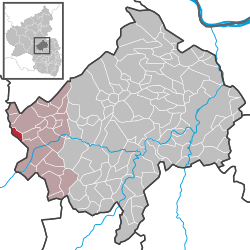Hahnenbach
| Hahnenbach | ||
|---|---|---|
|
||
| Coordinates: 49°48′39″N 7°25′07″E / 49.8107°N 7.41858°ECoordinates: 49°48′39″N 7°25′07″E / 49.8107°N 7.41858°E | ||
| Country | Germany | |
| State | Rhineland-Palatinate | |
| District | Bad Kreuznach | |
| Municipal assoc. | Kirn-Land | |
| Government | ||
| • Mayor | Stefan Fahlsing | |
| Area | ||
| • Total | 2.79 km2 (1.08 sq mi) | |
| Elevation | 220 m (720 ft) | |
| Population (2015-12-31) | ||
| • Total | 515 | |
| • Density | 180/km2 (480/sq mi) | |
| Time zone | CET/CEST (UTC+1/+2) | |
| Postal codes | 55606 | |
| Dialling codes | 06752 | |
| Vehicle registration | KH | |
Hahnenbach is an Ortsgemeinde – a municipality belonging to a Verbandsgemeinde, a kind of collective municipality – in the Bad Kreuznach district in Rhineland-Palatinate, Germany. It belongs to the Verbandsgemeinde of Kirn-Land, whose seat is in the town of Kirn, although this lies outside the Verbandsgemeinde. Hahnenbach is a state-recognized tourism community.
Hahnenbach lies on the like-named brook, the Hahnenbach, which empties into the Nahe near Kirn. Hahnenbach lies northwest of Kirn right at the boundary with the neighbouring Birkenfeld district.
Clockwise from the north, Hahnenbach’s neighbours are the municipalities of Hennweiler and Oberhausen bei Kirn and the town of Kirn, all of which likewise lie within the Bad Kreuznach district, while the municipalities of Bergen, Griebelschied and Sonnschied all lie in the neighbouring Birkenfeld district. Hahnenbach also comes to within a few metres of the municipality of Bruschied (Bad Kreuznach district), but does not touch it.
Like the neighbouring village of Hennweiler (formerly known as Hanenwilare), the name Hahnenbach (formerly known as Hanenbach) may go back to a common forename that cropped up in a Frankish noble clan, the Haganons. They were, beginning in the 7th century, enfeoffed and resident as members of a so-called Imperial nobility in the Rhenish Hesse area. This clan’s descendants are believed to have made land arable and founded settlements in the 7th and 8th centuries when the woodlands between the Moselle and the Nahe were opened up. Many placenames therefore go back to a village’s owner, founder or head from whom the original homestead, or later the village, drew its name. In the High and Late Middle Ages, Hahnenbach was held by the Lords of Stein (Steinkallenfels), that is to say, the villagers were liable to the lords of that castle for service and taxes. After Castle Wartenstein had been built by Sir Tilmann vom Stein (1357), Hahnenbach became part of the Lordship, and later Amt of Wartenstein, which was made up of the Unterämter of Hennweiler and Hahnenbach or Weiden. Belonging to the Unteramt of Hahnenbach/Weiden were the villages of Hahnenbach, Weiden and Herborn as well as parts of Niederhosenbach and Königsau. While the Amt of Hennweiler lay under Palatinate-Zweibrücken sovereignty, in the Amt of Hahnenbach the Prince-Archbishop-Elector of Trier was the overlord. Beginning in the 16th century, both Ämter were governed from Wartenstein by an Amtmann in personal union. After various families from the lesser nobility had exercised lordly rights in the Amt of Wartenstein beginning about 1400, in the 16th century, the Lords of Schwarzenberg became the sole lords in the Imperially immediate lordship of Wartenstein, and after they died out in 1583, the Lords of Warsberg succeeded them. This lordship persisted until French Revolutionary troops overran and occupied the German lands on the Rhine’s left bank in the late 18th century. In 1688, Castle Wartenstein was destroyed by the French during the Nine Years' War (known in Germany as the Pfälzischer Erbfolgekrieg, or War of the Palatine Succession). A new castle was then built in the years 1704-1728. During French Revolutionary, and later Napoleonic, times (1798-1814), Hahnenbach was one of 12 outlying, rural municipalities that were grouped together with the main town of Kirn to form the Mairie (“Mayoralty”) of Kirn, which in turn belonged to the Arrondissement of Simmern. After the French had been driven out and the Congress of Vienna imposed a new political order on post-Napoleonic Europe, Hahnenbach found itself in the Kingdom of Prussia, and after a short time in the Simmern district (1815-1816) and then in the Oberstein district (1816-1817), the Bürgermeisterei of Kirn, as the old French mayoralty was now called, passed on 16 April 1817 to the Kreuznach district. Hahnenbach remained a municipality within this body, which through several rounds of administrative restructuring (1817, 1858, 1894, 1927, 1940, 1969-1970) has become today’s Verbandsgemeinde of Kirn-Land. In 1957, a glassworks located in Hahnenbach, which brought about a doubling in the village’s population (to date). Many of the newcomers came from Thuringia.
...
Wikipedia



